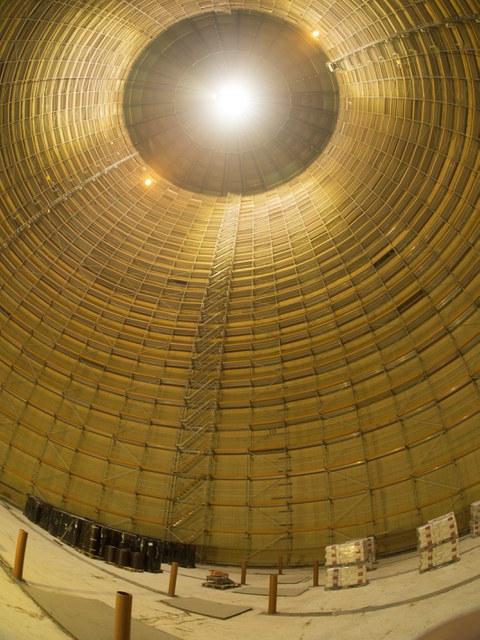Anwendung von Textilbeton bei einer Siloinstandsetzung
Inhaltsverzeichnis
Projektdaten
|
Titel | Title |
Bericht aus dem Jahrbuch 2015
Carbonbeton für Karamell

Gerüst im Inneren von Silo 9 der Nordzucker AG
Am 26. Juni 2014 wurde das ein Jahr zuvor in Betrieb genommene und 80.000 Tonnen Weißzucker fassende Silo 9 der Nordzucker AG in Uelzen durch einen Brand beschädigt. Neben der Entsorgung des weltgrößten Karamellbonbons musste im Anschluss auch der Beton auf der inneren Silowand ab einer Höhe von 25 m bis zum Ringbalken in 58 m Höhe instandgesetzt werden.
Zum Einsatz kam Textilbeton. Gleichzeitig konnte die industrielle und allgemeine Anwendbarkeit der 1. allgemeinen bauaufsichtlichen Zulassung (abZ) für die Textilbetonbauweise gezeigt werden. Der Umfang der abZ wäre grundsätzlich ausreichend gewesen, um das Projekt durchzuführen. Nur aufgrund eines notwendig werdenden Materialwechsels bei der Bewehrung wurde dann doch eine Zustimmung im Einzelfall im Vorgriff auf die Erweiterung der abZ erwirkt.
Für die Sanierung wurden ca. 14.000 m² Textilien innerhalb weniger Wochen durch die Firma V. Fraas produziert und durch Mitarbeiter der Implenia AG eingebaut. Zuerst wurde in den oberen zwei Dritteln des Silos die lose bzw. schadhafte Betondeckung durch Hochdruckwasserstrahlen abgetragen. Auf den so vorbereiteten und tragfähigen Untergrund wurde im Bedarfsfall eine Egalisierung aufgetragen und anschließend zwei bzw. drei Schichten Textilbeton in Ringrichtung eingebaut. Dazu wurden lediglich zwei Arbeiterteams im Zwei-Schichten-Betrieb gebraucht. Der Einbau der Textilbetonschichten im Sprühverfahren erweist sich hier als sehr vorteilhaft und schnell, wobei die Förderung des Sprühgutes auf einer Höhe von ca. 60 m eine gewisse Herausforderung darstellte.
Die in der Zulassung vorgesehene Fertigmischung – Pagel TF10 – konnte ohne Modifizierung verwendet werden. Auch dort, wo drei Schichten eingebaut wurden, erreicht die Textilbetonschicht lediglich eine Gesamtstärke von ca. 1,5 cm. Damit wird das Nutzvolumen des Silos nicht beeinträchtigt. Nach dem Aufbringen der Textilbetonschichten wurde die Oberfläche dann lediglich geschliffen und, nach dem Abbau des Gerüstes, mit einer lebensmittelechten Beschichtung versehen, bevor das Silo wieder mit Zucker gefüllt werden kann. Die Gebrauchstauglichkeit des Silos konnte voll wiederhergestellt werden und wir sind sicher, dass auch zukünftig kein Beton in den Zucker gelangen wird. Das Silo konnte fristgerecht zur neuen Zuckersaison übergeben werden.
